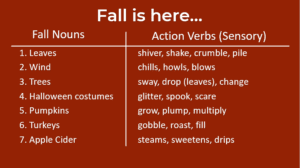How to teach descriptive writing when students don’t understand “show, don’t tell” is probably one of the hardest things for students to grasp, but these 3 small things can improve their “meh” writing in BIG ways. Also, it only takes a few minutes to practice!
Why descriptive writing is difficult to teach:
Kids know a good story when they read or hear or watch one, but they can’t necessarily pinpoint why. If the story has a lot of action or has awesome, relatable characters, then they like it. They just know it happens, and that they are hooked by a good story told well. However, when they try to write their own stories, they often gloss over the details or don’t notice how an author uses description in a piece of literature.
It takes a lot of practice over and over again. Of course, this takes time, and you have tons of standards to make sure your writers understand. So, the real reason descriptive writing is so difficult to teach is that it takes time. However, in just a few minutes a couple of times per week, you can practice these 3 ideas to get students writing with more specific detail. Additionally, they will notice those specific details more when they read as well. This will help them find the support they need for responses to literature and essays.
Trust me, it’s time well-spent!\\
Step 1: How to Teach Descriptive Writing: Mind Map
The first way to get students to improve description is to get them to mind map their description.
I always start off with a bell ringer for students to list down something to describe specifically, like favorite places or food. Then, the writer chooses ONE item from their list to describe.
For this example, I’m going to use a favorite place. For students, I demonstrate how I would mind map a place.
Then, I give students a mind map to follow that includes questions, like where? When (day or night?) (how long ago the experience was), what the place looked like, sounded like, felt like?
These first mind maps will usually be pretty superficial, with details of objects in a place, but not any action or sensory details for the most part. Therefore, that brings me to the next step to teaching descriptive writing.

Step 2: How to Teach Descriptive Writing: Use Sensory Detail Word Lists
Another way I get students to improve description is by showing them how to use a sensory word list to add sensory details.
For example, I give students the sensory details list I’ve developed that breaks all the senses down and gives them hundreds of words to describe things using the 5 senses.
First, I show students how the sensory word list is organized, and then I demonstrate how I use the list to add details to my mind map of a place.
Then, my writers add 2 sensory words to each object on their mind maps.
From there, I show students how I would organize my mind map and where I would start my writing, numbering off each potential sentence. They do the same.
Finally, students write their descriptions and share them with each other.
Step 3: How to Teach Descriptive Writing: Action Verb Activities
The third way that writers improve description is by using action verbs. Now, this takes some practice because middle school students forget what verbs are and how they function in a sentence.
Simple sentences illustrate the power of action verbs. Subject-action verb constructions create movement in a reader’s mind. Show students how easy it is to create these power sentences by using these simple activities:
Subject- Action Verb lists. I do this activity with my students several times throughout the school year. I learned the original activity from one of my very dear friends, Victoria.
The activity is a simple list of subjects and action verbs that use the senses. She used “Fall is here” as the topic. She had students create a list of fall nouns and then showed them how to use action verbs to make these objects move, smell, taste, and sound.

Then, her writers created a poem out of their lists. They could add other words after their action verbs to add more to their descriptive poems.
The power of this activity is that students begin to see that inanimate objects can seem to move, make sounds, or create a fragrance or flavor. For example, “turkeys roast” conjures multiple appeals to the senses – smell, taste, heat, flavor. All of this from two simple words.
Next steps for teaching description
I have students practice activities, similar to this one, multiple times throughout the school year. I usually start with describing a beach because it is the beginning of August when we go back to school, and we live in Florida. My writers listed 10 things they see on a beach. Then, they listed action verbs for each of these things.
Next, they wrote a description of a day at the beach.
I used a similar activity this past week when my writers described a favorite activity. This time they listed the verbs first, then the nouns. For example, I used cooking. I wrote a boring example of cooking pizza. Then, I wrote down 10 cooking verbs. I showed them my revised paragraph, and we discussed why this one was better.
As a result, students wrote their own activity paragraphs based on their 10 action verbs for their favorite activity with vibrant descriptive words.
Working on descriptive writing can be fun and rewarding…
All writers, even our middle school writers, can create powerful descriptions through planning, sensory details, and action verbs. The more they practice this in their own writing, the better. Also, you won’t be as bored with reading their “meh” descriptions that all start to sound the same after a while.
Also, by teaching students how writers capture a reader’s attention, their comprehension improves as they notice writers using these descriptive techniques over and over again.
If you’d like to know more about how to help your students improve their writing skills, teach them the 5 tricks to breaking writer’s block. You can pick up my free teacher’s guide by clicking on this link: www.teach2write.com/5tricks.
This guide comes with printable and digital student worksheets, videos that show you how I teach each of the 5 tricks, and a free subscription to my newsletter that gives you more techniques, tips and tricks for teaching writing in middle school.

